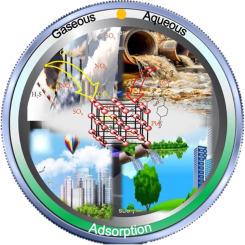金属有机框架的环境修复:吸附能力、机理和实际应用的最新进展
IF 4.7
2区 化学
Q2 CHEMISTRY, PHYSICAL
引用次数: 0
摘要
全球对可持续环境修复解决方案的迫切需求推动了先进技术的发展。有毒气体(COx, NOx, SOx, H2S, NH3), VOCs和水污染物(重金属,药物,染料,病原体)构成严重威胁。金属有机框架(MOFs)具有可调节的孔隙率和多功能性,是一种革命性的材料,在吸附、催化、气体储存和污染缓解传感方面表现出色。本文重点介绍了MOF的最新进展,包括新的合成方法、增强的性能以及可扩展的空气/水净化应用。对于CO₂捕获,Mg₂(dobdc)和CO₂(dobdc)在1巴,25°C时分别达到6.42 mmol g⁻1和6.90 mmol g⁻1。Cu₂Cl₂BBTA对NH₃(19.79 mmol g⁻)的吸附效果好,MIL-101(Cr)-4F(1%)对SO₂(18.4 mmol g⁻)的吸附效果好,MIL-101对H₂S (20 bar时38.4 mmol g⁻)的吸附效果好。MOF-5主要用于去除挥发性有机化合物(1367 mg g - 3氯甲烷)。染料吸附的突破包括刚果红的[Ln(L)]·Cl}n (2724 mg g⁻¹)和亚甲基蓝的DUT-23(Cu) (814 mg g⁻¹)。Zn-MOF(NH₂)显示出惊人的重金属容量:4874 mg g⁻(Pb2+), 4624 mg g⁻(Cu2+), 4261 mg g⁻(Hg2+)。PPCP吸附的特点是Ni/Co-MOF@CMC (625 mg g -四环素),MOF-525吸附的特点是可以去除807 mg g -四环素(抗生素)。ZIF-8先导农药吸附(367 mg g - 1 prothofos)。这些由酸碱、静电、π-π和氢键相互作用驱动的高容量强调了MOF的多功能性。未来的研究应侧重于人工智能设计、产业规模和循环经济整合,将MOFs定位为实现联合国可持续发展目标不可或缺的工具。本文章由计算机程序翻译,如有差异,请以英文原文为准。

Environmental remediation using metal-organic frameworks: Recent progress in adsorption capacities, mechanisms, and practical applications
Urgent global demand for sustainable environmental remediation solutions drives the development of advanced technologies. Toxic gases (COx, NOx, SOx, H2S, NH3), VOCs, and water contaminants (heavy metals, pharmaceuticals, dyes, pathogens) pose severe threats. Metal-organic frameworks (MOFs), with tunable porosity and multifunctionality, are revolutionary materials excelling in adsorption, catalysis, gas storage, and sensing for pollution mitigation. This review highlights cutting-edge MOF advancements, covering novel synthesis, enhanced properties, and scalable air/water purification applications. For CO₂ capture, Mg₂(dobpdc) and Co₂(dobdc) achieve 6.42 mmol g⁻¹ and 6.90 mmol g⁻¹ at 1 bar, 25 °C. Harmful gas adsorption excels with Cu₂Cl₂BBTA for NH₃ (19.79 mmol g⁻¹), MIL-101(Cr)-4F(1 %) for SO₂ (18.4 mmol g⁻¹), and MIL-101 for H₂S (38.4 mmol g⁻¹ at 20 bar). MOF-5 dominates VOC removal (1367 mg g⁻¹ trichloromethane). Dye adsorption breakthroughs include [Ln(L)]·Cl}n for Congo Red (2724 mg g⁻¹) and DUT-23(Cu) for Methylene Blue (814 mg g⁻¹). Zn-MOF(NH₂) shows extraordinary heavy metal capacities: 4874 mg g⁻¹ (Pb2+), 4624 mg g⁻¹ (Cu2+), 4261 mg g⁻¹ (Hg2+). PPCP adsorption features Ni/Co-MOF@CMC (625 mg g⁻¹ tetracycline), while MOF-525 removes 807 mg g⁻¹ tetracycline (antibiotics). ZIF-8 leads pesticide adsorption (367 mg g⁻¹ prothiofos). These high capacities, driven by acid-base, electrostatic, π-π, and H-bonding interactions, underscore MOF versatility. Future research should focus on AI design, industrial scaling, and circular economy integration to position MOFs as indispensable tools for achieving UN SDGs.
求助全文
通过发布文献求助,成功后即可免费获取论文全文。
去求助
来源期刊

Journal of Molecular Structure
化学-物理化学
CiteScore
7.10
自引率
15.80%
发文量
2384
审稿时长
45 days
期刊介绍:
The Journal of Molecular Structure is dedicated to the publication of full-length articles and review papers, providing important new structural information on all types of chemical species including:
• Stable and unstable molecules in all types of environments (vapour, molecular beam, liquid, solution, liquid crystal, solid state, matrix-isolated, surface-absorbed etc.)
• Chemical intermediates
• Molecules in excited states
• Biological molecules
• Polymers.
The methods used may include any combination of spectroscopic and non-spectroscopic techniques, for example:
• Infrared spectroscopy (mid, far, near)
• Raman spectroscopy and non-linear Raman methods (CARS, etc.)
• Electronic absorption spectroscopy
• Optical rotatory dispersion and circular dichroism
• Fluorescence and phosphorescence techniques
• Electron spectroscopies (PES, XPS), EXAFS, etc.
• Microwave spectroscopy
• Electron diffraction
• NMR and ESR spectroscopies
• Mössbauer spectroscopy
• X-ray crystallography
• Charge Density Analyses
• Computational Studies (supplementing experimental methods)
We encourage publications combining theoretical and experimental approaches. The structural insights gained by the studies should be correlated with the properties, activity and/ or reactivity of the molecule under investigation and the relevance of this molecule and its implications should be discussed.
 求助内容:
求助内容: 应助结果提醒方式:
应助结果提醒方式:


